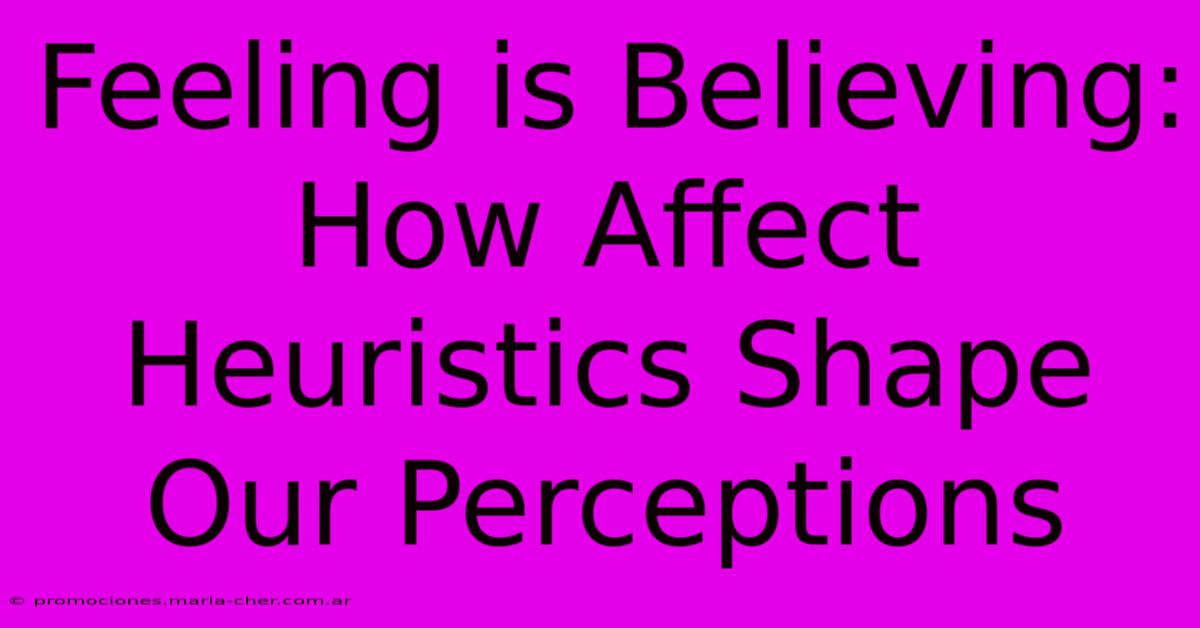Feeling Is Believing: How Affect Heuristics Shape Our Perceptions

Table of Contents
Feeling is Believing: How Affect Heuristics Shape Our Perceptions
We often pride ourselves on our rationality, our ability to make decisions based on logic and reason. Yet, a significant body of research reveals a powerful, often unconscious force shaping our judgments: affect heuristics. This psychological shortcut relies on our feelings – our gut reactions – to guide our perceptions and decisions, sometimes overriding even our most reasoned assessments. Understanding how affect heuristics work is crucial to navigating the complexities of everyday life and making better, more informed choices.
What are Affect Heuristics?
Affect heuristics are mental shortcuts that link our immediate emotional responses (affect) to judgments and decisions. Instead of meticulously weighing pros and cons, we rely on a quick, intuitive assessment: "How do I feel about this?" This feeling then colors our perception of the situation, influencing our judgment of its risks, benefits, and overall value. For example, if we feel good about a product, we're more likely to perceive it as high-quality and safe, even without concrete evidence. Conversely, a negative feeling can lead us to perceive something as dangerous or undesirable.
The Speed and Efficiency of Affect
The power of affect heuristics lies in their speed and efficiency. Our brains are constantly bombarded with information; relying on emotions allows us to make rapid judgments without extensive cognitive processing. This is particularly useful in situations where time is limited or information is incomplete. However, this efficiency comes at a cost. Because our feelings are often based on incomplete or biased information, they can lead to inaccurate or illogical conclusions.
Examples of Affect Heuristics in Action
The influence of affect heuristics is pervasive, affecting numerous aspects of our lives:
- Product Choice: Marketing campaigns heavily leverage affect heuristics. Appealing visuals, catchy jingles, and positive brand associations aim to evoke positive feelings, leading consumers to perceive the product more favorably.
- Risk Perception: Fear and anxiety can drastically skew our perception of risk. We tend to overestimate the likelihood of rare but emotionally impactful events (like plane crashes) while underestimating more common but less emotionally charged risks (like car accidents).
- Political Attitudes: Our feelings towards political candidates often influence our judgments of their policies and character. A charismatic leader may be perceived as more competent, even if their policies are objectively less effective.
- Investment Decisions: Investors can be influenced by gut feelings, leading them to make impulsive buys or sells based on fleeting emotions rather than sound financial analysis.
The Cognitive Bias of Affect
Affect heuristics are closely related to various cognitive biases, reinforcing their impact on our judgments:
- Confirmation bias: We tend to seek out information confirming our pre-existing feelings, ignoring contradictory evidence. If we feel positively about a company, we might only focus on positive news stories, ignoring negative ones.
- Availability heuristic: We overestimate the likelihood of events that are easily recalled, often because they are emotionally charged. A recent news story about a shark attack might make us overestimate the risk of shark attacks, even if statistically they are rare.
Overcoming the Influence of Affect Heuristics
While affect heuristics are a powerful force, we can learn to mitigate their influence:
- Increase self-awareness: Recognizing that your feelings might be influencing your judgment is the first step to making more rational decisions. Pause and reflect on the basis of your feelings.
- Seek diverse information: Actively seek out information that challenges your initial emotional response. Consider different perspectives and avoid relying solely on information that confirms your existing biases.
- Utilize analytical frameworks: Employ structured decision-making tools to break down complex problems into smaller, more manageable components. This can help to minimize the sway of emotions.
- Delay decisions: When possible, postpone important decisions until your emotions have subsided. This provides time for more rational thought.
Conclusion: The Importance of Balanced Thinking
Affect heuristics are an inherent part of human cognition. While they provide efficiency, they can also lead to errors in judgment. By understanding how they operate and developing strategies to mitigate their influence, we can cultivate a more balanced approach to decision-making, relying on both reason and emotion to navigate the complexities of our world. Learning to recognize the subtle yet profound impact of our feelings is key to developing critical thinking skills and achieving better outcomes in all aspects of life.

Thank you for visiting our website wich cover about Feeling Is Believing: How Affect Heuristics Shape Our Perceptions. We hope the information provided has been useful to you. Feel free to contact us if you have any questions or need further assistance. See you next time and dont miss to bookmark.
Featured Posts
-
Your Brain On Advertising How Fallacies Influence Your Behavior This Will Blow Your Mind
Feb 07, 2025
-
The Ultimate Guide To Response Bias Empowering Your Decision Making Journey
Feb 07, 2025
-
Beat Back Pain Without Breaking The Bank The Insiders Guide To Epidural Steroids
Feb 07, 2025
-
Virginias Heart Attack Hospital Costs Breaking The Bank Or Breaking Your Heart
Feb 07, 2025
-
Floral Elegance Without The Cost The Secret To Affordable Baby Breath
Feb 07, 2025
